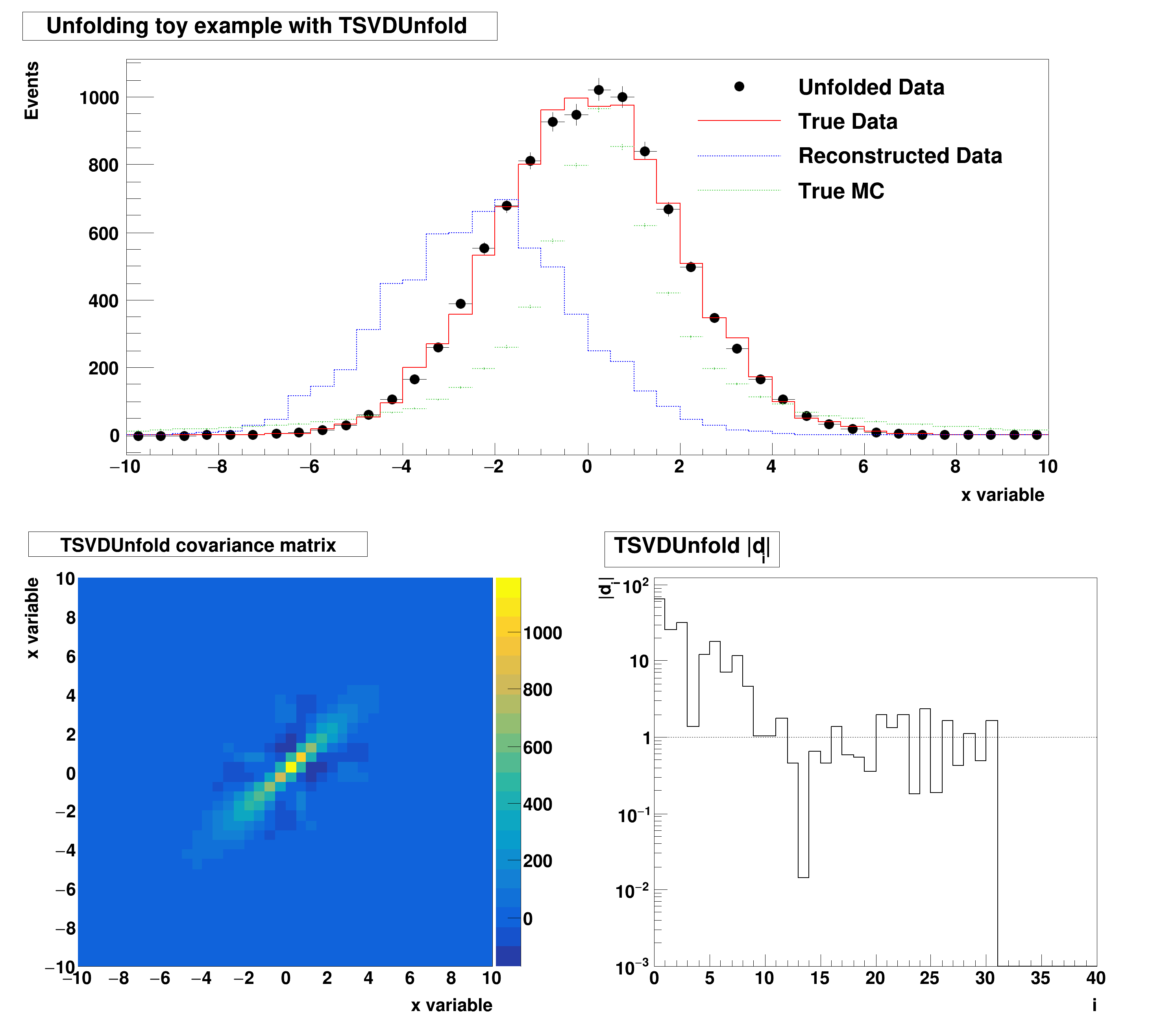#include <iostream>
{
Double_t xeff = 0.3 + (1.0 - 0.3)/20.0*(xt + 10.0);
if (
x > xeff)
return cutdummy;
else {
return xt+xsmear;
}
}
void TSVDUnfoldExample()
{
gROOT->SetStyle(
"Plain");
TH1D *xini =
new TH1D(
"xini",
"MC truth", nbins, -10.0, 10.0);
TH1D *bini =
new TH1D(
"bini",
"MC reco", nbins, -10.0, 10.0);
TH2D *Adet =
new TH2D(
"Adet",
"detector response", nbins, -10.0, 10.0, nbins, -10.0, 10.0);
TH1D *data =
new TH1D(
"data",
"data", nbins, -10.0, 10.0);
TH1D *datatrue =
new TH1D(
"datatrue",
"data truth", nbins, -10.0, 10.0);
TH2D *statcov =
new TH2D(
"statcov",
"covariance matrix", nbins, -10.0, 10.0, nbins, -10.0, 10.0);
for (
Int_t i= 0; i<100000; i++) {
}
}
for (
Int_t i=0; i<10000; i++) {
}
cout << "Created toy distributions and errors for: " << endl;
cout << "... \"true MC\" and \"reconstructed (smeared) MC\"" << endl;
cout << "... \"true data\" and \"reconstructed (smeared) data\"" << endl;
cout << "... the \"detector response matrix\"" << endl;
}
ustatcov->
Add( uadetcov );
utaucov->
Add( uadetcov );
}
leg->AddEntry(unfres,
"Unfolded Data",
"p");
leg->AddEntry(datatrue,
"True Data",
"l");
leg->AddEntry(data,
"Reconstructed Data",
"l");
leg->AddEntry(xini,
"True MC",
"l");
TCanvas *
c1 =
new TCanvas(
"c1",
"Unfolding toy example with TSVDUnfold", 1000, 900 );
frame->
SetTitle(
"Unfolding toy example with TSVDUnfold" );
c2->SetRightMargin ( 0.15 );
covframe->
SetTitle(
"TSVDUnfold covariance matrix" );
ustatcov->
Draw(
"colzsame" );
dframe->
SetTitle(
"TSVDUnfold |d_{i}|" );
}
#define R(a, b, c, d, e, f, g, h, i)
R__EXTERN TStyle * gStyle
virtual void SetTitleOffset(Float_t offset=1)
Set distance between the axis and the axis title.
virtual void SetLineStyle(Style_t lstyle)
Set the line style.
virtual void SetLineWidth(Width_t lwidth)
Set the line width.
virtual void SetLineColor(Color_t lcolor)
Set the line color.
virtual void SetMarkerStyle(Style_t mstyle=1)
Set the marker style.
1-D histogram with a double per channel (see TH1 documentation)}
virtual void SetTitle(const char *title)
See GetStatOverflows for more information.
virtual Double_t GetBinError(Int_t bin) const
Return value of error associated to bin number bin.
TAxis * GetXaxis()
Get the behaviour adopted by the object about the statoverflows. See EStatOverflows for more informat...
virtual Int_t GetNbinsX() const
virtual Bool_t Add(TF1 *h1, Double_t c1=1, Option_t *option="")
Performs the operation: this = this + c1*f1 if errors are defined (see TH1::Sumw2),...
virtual void SetBinError(Int_t bin, Double_t error)
Set the bin Error Note that this resets the bin eror option to be of Normal Type and for the non-empt...
virtual Int_t Fill(Double_t x)
Increment bin with abscissa X by 1.
virtual void SetMinimum(Double_t minimum=-1111)
virtual Double_t Integral(Option_t *option="") const
Return integral of bin contents.
virtual void Draw(Option_t *option="")
Draw this histogram with options.
virtual void Scale(Double_t c1=1, Option_t *option="")
Multiply this histogram by a constant c1.
2-D histogram with a double per channel (see TH1 documentation)}
Int_t Fill(Double_t)
Invalid Fill method.
virtual Double_t GetBinContent(Int_t bin) const
Return content of bin number bin.
virtual void SetBinContent(Int_t bin, Double_t content)
Set bin content.
This class displays a legend box (TPaveText) containing several legend entries.
virtual void SetTitle(const char *title="")
Set the title of the TNamed.
virtual void Draw(Option_t *option="")
Default Draw method for all objects.
Random number generator class based on M.
SVD Approach to Data Unfolding.
TH1D * GetSV() const
Returns singular values vector.
TH2D * GetXtau() const
Returns the computed regularized covariance matrix corresponding to total uncertainties on measured s...
TH1D * Unfold(Int_t kreg)
Perform the unfolding with regularisation parameter kreg.
void SetNormalize(Bool_t normalize)
TH1D * GetD() const
Returns d vector (for choosing appropriate regularisation)
TH2D * GetUnfoldCovMatrix(const TH2D *cov, Int_t ntoys, Int_t seed=1)
Determine for given input error matrix covariance matrix of unfolded spectrum from toy simulation giv...
TH2D * GetAdetCovMatrix(Int_t ntoys, Int_t seed=1)
Determine covariance matrix of unfolded spectrum from finite statistics in response matrix using pseu...
TH2D * GetXinv() const
Returns the computed inverse of the covariance matrix.
void SetOptStat(Int_t stat=1)
The type of information printed in the histogram statistics box can be selected via the parameter mod...
TVirtualPad is an abstract base class for the Pad and Canvas classes.
virtual TVirtualPad * cd(Int_t subpadnumber=0)=0
virtual void Divide(Int_t nx=1, Int_t ny=1, Float_t xmargin=0.01, Float_t ymargin=0.01, Int_t color=0)=0
Double_t Sqrt(Double_t x)

 Data unfolding using Singular Value Decomposition
Data unfolding using Singular Value Decomposition 